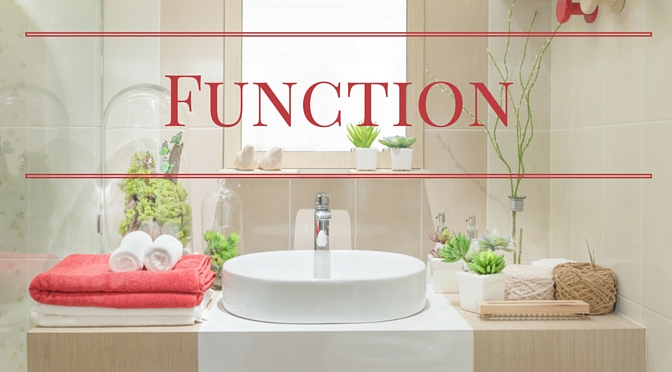
It’s Important to Determine the Function of Your Room Before You Begin Your Project.
In our previous newsletter, we started a series on “How to Measure Your Project Success” and talked about goals. You can read it here.
Now that you’ve established your goal(s), it’s important to determine what function, or tasks, the room or space should do for you. You know how furniture and appliances work. But how do they function as a room? And how well will the room work for its inhabitants?
Once again, we start with questions…
- Who lives here?
- Who’s going to use this space?
- How does the room or space currently function?
- Will the function remain the same or change?
- How could it function better?
- Are there any special needs for the room?
- Are there any other functions you’d like your room to have?
We’ll view these questions through a project I did for a mature client a few years ago…
How a Senior Citizen enriched her Historic Home with the Bath of her Dreams.
The original design placed two bathrooms and a storage room between two bedrooms, all of which opened to the hallway. Imagine walking along this ‘dorm’ style of cramped, dark rooms with no connection or privacy. Both bathrooms lacked a shower and the 50’s style décor could only be described as depressing.
Not optimal for any age, this design was especially poor for a woman in her 80’s determined to live there as long as she had a say.
The first two questions, “Who lives here” and “Who’s going to use this space” are obvious. It was my client, and her guests.
We needed to open it up…make it functional, safe, and beautiful.
Here’s the catch…
It had to be done with universal appeal for every age.
“How do the rooms currently function?” This layout was rife with weaknesses:
- Every room could only be entered from the hallway, which required extra steps and allowed no privacy.
- Bathing options were limited with only high barrier tubs.
- Small rooms limited free movement, and left no space for assistance.
- The storage closet was so tiny it was almost useless.
The one thing going for it was comfort height toilets, but the grab bars were poorly placed.
And we’re not done yet! Less obvious issues included:
- Inadequate lighting in spite of outside windows.
- Poor spacing around the toilet and sink to accommodate the possibility of needing a wheel chair. (Note – wheel chairs aren’t only for the elderly.)
- Walls and floor with poor finishes that didn’t contrast well.
- Every room appeared small and ‘old’.
Let’s focus just on the master bed and bathroom. Each room would continue with the same function, but they needed to function better.
- First, we walled off the bathroom door to create an in-suite arrangement. She has shorter, easier access to her bathroom with total privacy – a big plus when she has company. (In addition, we took out the storage room and made both bathrooms more spacious while adding storage space to each.)
- Next, we replaced the tub with a Curbless shower for easy in-and-out access. This style, already popular in Europe, allows two shower options with wall-mounted and hand-held showerheads. It’s not only safer; it adds a sleek modern look to the entire bathroom. Talk about an easy update!
- She now has a well-spaced toilet and sink for easy movement around both. If she needs assistance in the future, there’s plenty of room to maneuver.
- Canned lighting in the ceiling supplements the window’s natural light and the fixtures on either side of the mirror contain night-lights. The combination minimizes shadows that can confuse anyone of any age, especially at night.
- Light floors tiles (accented with black tiles) and light grey walls brighten the already improved lighting. Most people don’t realize how glossy surfaces confuse the eye. Matte finishes contrast better and add to the timeless appearance of the entire room.
- Finally, the Grab Bars, also known as Balance Bars. “You’ve come a long way, baby!” applies to the versatility and appeal of Balance Bars. Now part of the décor, various styles and finishes make them good for towel holders as well as support. In this case, we completed her updated appearance with brushed nickel to match the hardware in both the sink and shower.
Now we’re to the point of asking, “Are there any special needs for the room?” Think about it, every room has special needs at some point. You don’t have to be elderly to need assistance with mobility. Temporary situations can hamper physical capabilities at any age and we never think it’ll happen to us…until it does.
Finally, “Are there any other functions?”
In this case, a resounding YES! If you’ll recall in the last Newsletter, we defined what Beauty, Function, and Safety mean in our homes. My very independent client understands the value of feeling safe because her home functions well. She loves the changes for those reasons, and one more…its timeless beauty. (Virtually every guest gets a tour!)
Her in-suite bedroom/bath is a modern update that belies her age. The time will come when she’ll have to sell; but she’s vaulted ahead the competition by embracing Universal Design and tapping my specialty of Aging in Place.
You can see photos of the entire project here.
With this example, I hope you can see why I believe in my resource, The 4 BEST Interior Design Tools …EVER!. You can download it by clicking on the photo below:
I have additional resources such as, 10 Easy Ways to Maximize Your Independence, and 12 Interior Design Secrets You Should Know BEFORE You Start a Project.
If you haven’t already downloaded these, you can do it FREE by clicking on them, or go to www.DesignForALifespan.com to see more pictures and additional projects.
With a consultation, I can show you not only how to get the room(s) of your dreams now; but transform your home for the present and the future.
You can contact me at [email protected] or call 480-695-1360.
Live easy,
Jeanette

